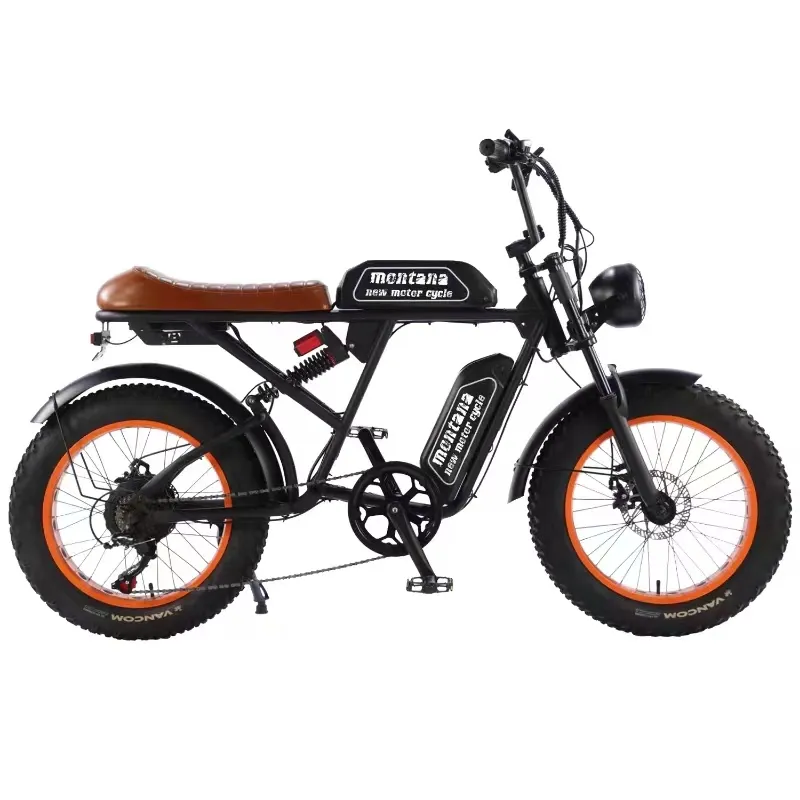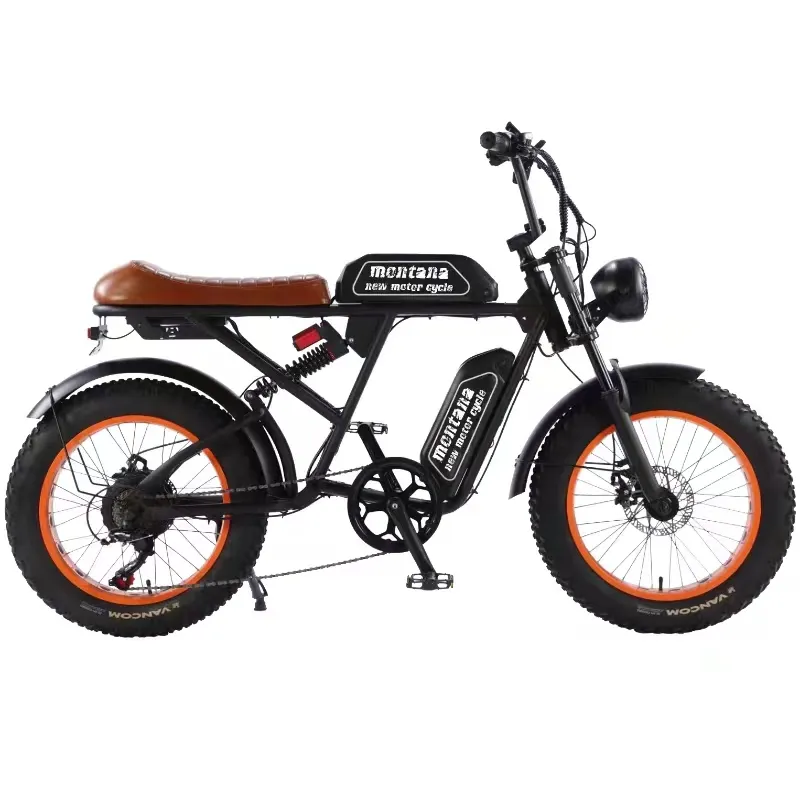Aug . 17, 2025 02:20 Back to list
24-inch Electric Bikes: Compact & Agile City Rides
The Strategic Imperative of 24-Inch Electric Bikes in Modern Logistics and Urban Mobility
The landscape of urban transportation and last-mile logistics is undergoing a profound transformation, largely driven by the adoption of electric vehicles. Within this paradigm shift, the 24 inch electric bike is emerging as a pivotal asset, offering a compelling blend of maneuverability, efficiency, and sustainability. This segment of the electric bicycle market caters to a diverse array of applications, from individual commuters seeking agile transit solutions to businesses optimizing their delivery operations. The compact yet capable design of a 24 inch electric bike provides an optimal balance, ensuring ease of navigation through congested urban environments while retaining the necessary power and range for extended usage. Furthermore, the increasing focus on environmental sustainability and reduced operational costs is pushing enterprises towards electric alternatives, positioning the 24 inch electric bike as a strategic investment. Understanding the intricate technical specifications, manufacturing precision, and versatile application scenarios of these bikes is crucial for B2B stakeholders aiming to future-proof their fleets and enhance service delivery. The current market trend indicates a clear surge in demand for smaller, more versatile electric transport solutions, making this specific wheel size particularly relevant for high-density urban settings and specialized tasks requiring nimble movement. This comprehensive analysis will delve into the technical prowess, manufacturing excellence, and strategic advantages offered by advanced 24 inch electric bike models, providing insights valuable for procurement managers, logistics planners, and urban mobility strategists.
The evolution of battery technology, motor efficiency, and lightweight frame materials has significantly enhanced the performance envelope of the 24 inch electric bike, making it a viable alternative to traditional gasoline-powered vehicles for specific logistical challenges. Businesses engaged in food delivery, parcel delivery, or on-demand services are increasingly recognizing the operational benefits, including lower fuel costs, reduced maintenance, and simplified parking. Moreover, regulatory frameworks in many cities are becoming more favorable towards electric micromobility, often providing incentives or preferential access that further cement the business case for adopting electric bicycles. The strategic procurement of these units requires a deep understanding of their lifecycle, from manufacturing quality and material sourcing to after-sales support and spare part availability. The versatility of the 24 inch electric bike extends beyond logistics, finding utility in corporate campuses for internal transport, security patrols, and even within specialized industrial environments where quiet, emission-free transport is required. This adaptability, combined with advancements in smart connectivity and integrated telemetry systems, transforms the 24 inch electric bike from a simple mode of transport into a sophisticated operational tool capable of delivering measurable ROI. The global market for electric bikes is projected to continue its robust growth trajectory, driven by factors such as urbanization, environmental consciousness, and technological innovation, firmly establishing the 24 inch electric bike as a key player in this burgeoning industry.
Precision Engineering: The Manufacturing Process of a 24-Inch Electric Bike
The production of a high-quality 24 inch electric bike is a sophisticated multi-stage process that emphasizes precision, material integrity, and adherence to stringent quality control standards. It begins with the selection of premium materials, typically aircraft-grade aluminum alloys (6061 or 7005 series) or high-tensile steel for the frame, chosen for their optimal strength-to-weight ratio and fatigue resistance. The frame manufacturing often involves advanced techniques such as hydroforming, which uses high-pressure fluid to shape tubes into complex geometries, enhancing stiffness and reducing weight. This is followed by robotic welding (TIG or MIG) to ensure consistent, strong joints, critical for structural integrity and rider safety. Components like dropouts, motor mounts, and battery enclosures are frequently produced via CNC machining from solid billets, providing unparalleled dimensional accuracy and seamless integration with the main frame. Each weld and machined part undergoes rigorous non-destructive testing, including ultrasonic inspection and X-ray analysis, to detect any microscopic flaws. For critical components like the suspension forks or specialized brackets, precision casting or forging might be employed to achieve specific mechanical properties and intricate shapes. The application of durable, corrosion-resistant coatings, often through electrostatic powder coating, not only enhances aesthetic appeal but also provides long-term protection against environmental elements, significantly extending the bike's lifespan, particularly in demanding operational environments such as urban delivery where exposure to varying weather conditions is common.
Following the frame's structural completion, the assembly phase integrates the complex electrical and mechanical systems. This includes the installation of the brushless DC hub motor or mid-drive motor, selected for its efficiency and low maintenance, followed by the secure housing of the lithium-ion battery pack, often equipped with an advanced Battery Management System (BMS) to ensure optimal performance, longevity, and safety against overcharge or discharge. Wiring harnesses are meticulously routed and secured, adhering to IP (Ingress Protection) ratings to guard against dust and water ingress, crucial for the reliability of an electric bike for delivery. Components like the display unit, throttle, pedal-assist sensor (PAS), and hydraulic or mechanical disc brakes are then precisely calibrated. Each manufacturing stage is benchmarked against international standards such as ISO 9001 for quality management and ISO 14001 for environmental management, ensuring responsible and high-quality production. Furthermore, product-specific certifications like UL 2849 for electric bicycles, CE marking for European conformity, and RoHS compliance for hazardous substances are diligently pursued. These certifications provide a robust assurance of quality, safety, and regulatory adherence, instilling confidence in B2B buyers seeking reliable and compliant fleet solutions. The entire process culminates in comprehensive end-of-line testing, including dynamic load tests, range verification, and electrical safety checks, guaranteeing that every 24 inch electric bike meets stringent performance and safety criteria before dispatch.

Key Technical Parameters and Performance Metrics
When evaluating a 24 inch electric bike for commercial applications, a detailed understanding of its technical parameters is paramount. Critical specifications include motor power, typically ranging from 250W to 750W (or higher for specific jurisdictions), which dictates acceleration and climbing capability, essential for navigating varied urban terrains. Battery capacity, measured in Watt-hours (Wh), directly correlates to the bike's range, with higher capacities offering longer operational durations between charges, vital for delivery services or extended shifts. For instance, a 48V 10.4Ah battery provides 499.2Wh, capable of delivering a range between 30-50 miles depending on assist level and terrain. Torque output from the motor is another critical metric, particularly for hauling loads or tackling inclines, often expressed in Newton-meters (Nm). Frame material, as discussed, influences overall weight and durability; lighter aluminum frames are preferred for agile urban use, while robust steel frames might suit heavier duty cycles. Furthermore, the type of braking system (hydraulic vs. mechanical disc brakes) significantly impacts stopping power and safety, especially with increased speeds and payloads. Advanced models often integrate intelligent controllers that manage power delivery, optimize battery usage, and provide multiple pedal-assist levels, enhancing rider control and efficiency. Understanding these technical nuances allows businesses to select a 24 inch electric bike that precisely matches their operational demands and ensures optimal performance and longevity in fleet environments.
Beyond the core power components, other technical specifications contribute significantly to the user experience and operational efficiency of a 24 inch electric bike. Gearing systems, such as a Shimano 7-speed drivetrain, provide flexibility for different speeds and gradients, allowing riders to maintain an optimal cadence even without electric assistance. Tire width and tread pattern, exemplified by "4.0 Wide Snow Tires" on certain models, can dramatically improve stability, traction, and comfort across diverse surfaces, from slick city streets to uneven paths, crucial for an electric bike for delivery. Integrated lighting systems (front and rear LED lights), often powered by the main battery, enhance visibility and safety during night operations. The type of display (LCD or LED) and its functionality, including speedometer, odometer, battery indicator, and assist level, directly impacts rider information and control. Cargo carrying capacity, often facilitated by integrated racks or provisions for aftermarket accessories, is a key consideration for commercial applications. The ingress protection (IP) rating of electrical components signifies their resistance to dust and water, a critical factor for reliability in outdoor use. By meticulously reviewing these technical parameters, procurement teams can make informed decisions that align with their operational objectives, ensuring the deployed 24 inch electric bike fleet delivers maximum utility and minimum downtime.
Comparative Analysis: 24-Inch Electric Bike Parameters
Diverse Applications and Strategic Advantages of 24-Inch Electric Bikes
The adaptability of the 24 inch electric bike positions it as a highly versatile solution across various B2B sectors, delivering distinct advantages over conventional transport methods. In urban logistics, particularly for last-mile delivery services, these bikes excel due to their compact footprint, enabling rapid navigation through dense traffic and effortless parking in areas inaccessible to larger vehicles. This directly translates into faster delivery times and reduced operational costs associated with fuel consumption and parking fees, critical metrics for an electric bike for delivery fleet. Food delivery platforms, courier services, and local businesses seeking efficient, environmentally friendly transport solutions find the agility and low overhead of these bikes indispensable. Beyond immediate logistics, the 24 inch electric bike also proves invaluable for internal transport within large industrial complexes, university campuses, or sprawling resorts, providing quick and silent movement for staff, security personnel, and light equipment. Their quiet operation and zero tailpipe emissions make them ideal for indoor environments or areas with strict noise and air quality regulations. The robust construction and reliable components ensure a longer operational lifespan and lower total cost of ownership compared to alternatives requiring more frequent maintenance or higher energy inputs.
Furthermore, the low barrier to entry and ease of operation inherent in a 24 inch electric bike reduces training requirements for fleet operators. Their intuitive design makes them accessible to a broader range of riders, expanding the potential workforce for delivery or on-site transportation roles. For businesses looking to enhance their corporate social responsibility profile, investing in an electric bike fleet underscores a commitment to sustainability, resonating positively with both customers and employees. Customization options, such as specialized cargo racks for specific payload requirements or branding opportunities, further extend their utility and integration into existing business operations. Consider a rental service, for instance, that offers tourists the chance to `shop electric bike` options or explore cities on an `e bike trike` for stability – a 24-inch variant offers an excellent entry point due to its manageable size and comfortable ride. Our company, Yanline Bike, specializes in robust models like the Electric Bike 20-Inch 4.0 Wide Snow Tires Rear 7-Speed Two-Wheel Lithium Battery, which, despite its 20-inch base, showcases the principles of rugged design and high performance relevant to all urban-focused electric bikes, including 24-inch models. This product, designed for challenging conditions with its wide snow tires, exemplifies the durability and specialized performance that can be adapted and scaled for various B2B needs, including more compact 24 inch electric bike variants focused on urban agility.

Customization Solutions and Exemplary Application Cases
For B2B clients, the ability to customize a 24 inch electric bike to precise operational requirements is a significant value proposition. Customization can range from specific cargo solutions, such as insulated delivery boxes for food services or durable panniers for tool transport, to integrated GPS tracking systems for fleet management and security. Branding opportunities are also critical; applying company logos and colors transforms the bike into a mobile billboard, enhancing brand visibility. Manufacturers like Yanline Bike offer flexible production lines capable of accommodating custom frame geometries, specialized motor configurations, or unique battery capacities to meet diverse range and power demands. For instance, a postal service might require a 24 inch electric bike with enhanced front-load carrying capacity and robust kickstands, while a campus security team might prioritize integrated sirens, flashing lights, and secure storage for equipment. The selection of specific components, such as heavy-duty tires for varied terrains or ergonomic seating for prolonged use, can significantly impact rider comfort and operational efficiency. Furthermore, integrating smart technology, including telematics for remote diagnostics and performance monitoring, allows businesses to optimize routes, track asset utilization, and pre-emptively manage maintenance schedules, contributing to a more efficient and reliable fleet.
Numerous real-world application cases demonstrate the efficacy of the 24 inch electric bike in diverse commercial settings. A prominent example is a leading parcel delivery company in a major European capital that replaced a significant portion of its urban van fleet with electric bike for delivery solutions, primarily utilizing 24-inch models for their agility in narrow streets. This transition resulted in a 30% reduction in delivery times within congested zones and a staggering 60% decrease in operational fuel costs, alongside a substantial improvement in their carbon footprint. Another case involves a large university in North America that deployed a fleet of custom-branded 24 inch electric bike units for internal campus logistics, enabling staff to quickly transport documents, equipment, and supplies across the sprawling campus. This initiative not only improved inter-departmental efficiency but also promoted a greener campus environment. Even niche applications like an `e bike store` looking to offer test rides of various models, including an `e bike trike` variant with 24-inch wheels for enhanced stability, leverage the versatility and appeal of this size. These success stories underscore the tangible benefits—from cost savings and environmental stewardship to enhanced operational agility and improved public perception—that businesses can achieve by strategically integrating a 24 inch electric bike into their operational framework.
Trustworthiness, Support, and Future Outlook
Establishing trustworthiness is paramount for B2B procurement of high-value assets like a 24 inch electric bike fleet. Reputable manufacturers distinguish themselves through transparent operations, adherence to international quality standards, and robust customer support. This includes comprehensive warranties, typically ranging from 1 to 5 years on frame and components, and a dedicated technical support team accessible for troubleshooting and maintenance guidance. A clear delivery schedule and logistics plan are also vital, ensuring timely receipt and deployment of units, minimizing disruption to business operations. For example, our commitment at Yanline Bike includes providing detailed shipping estimates, comprehensive tracking, and secure packaging to ensure products arrive in pristine condition. Furthermore, the availability of readily accessible spare parts and a network of authorized service centers significantly contributes to the long-term viability and ease of maintenance of an electric bike for delivery fleet. Pre-purchase consultation services, where specialists help tailor solutions to specific business needs, further enhance buyer confidence and ensure the chosen 24 inch electric bike solution is perfectly aligned with operational demands.
Frequently Asked Questions (FAQ)
-
Q: What is the typical lifespan of a 24-inch electric bike's battery?
A: Lithium-ion batteries in quality 24 inch electric bike models are designed for 800-1000 charge cycles, equating to 3-5 years of typical commercial use, after which capacity may gradually decrease. Proper charging and storage can extend this lifespan. -
Q: Are these bikes suitable for all-weather operation?
A: Many commercial-grade electric bike for delivery models, including those from our range, feature components with IP ratings (e.g., IP65) for water and dust resistance, making them suitable for light to moderate rain and varying weather conditions. Models with wider tires, like our 4.0-inch snow tires, offer enhanced grip in challenging conditions. -
Q: What maintenance is required for a fleet of 24-inch electric bikes?
A: Regular maintenance for a 24 inch electric bike fleet involves routine checks of tires, brakes, chain lubrication, and electrical connections. Battery health monitoring and occasional motor inspection are also recommended. Comprehensive maintenance guides and training for fleet managers are typically provided by reputable manufacturers.
Academic and Industry References
- European Cyclists' Federation. (2023). Electric Bicycle Market Report: Growth Trends and Policy Implications.
- Smith, J. A., & Chen, L. (2022). "The Role of Micromobility in Sustainable Urban Logistics: A Case Study on Electric Bike Adoption." Journal of Transport Research Part A: Policy and Practice, 165, 104598.
- International Organization for Standardization. (2015). ISO 9001:2015 Quality management systems — Requirements.
- Underwriters Laboratories. (2020). UL 2849 Standard for Electric Bicycles.
-
Discover Top E Bike Brand Insights, Specs & Future Trends | Yanline Bike
NewsNov.24,2025
-
Green E Bike – The Future of Sustainable Urban Mobility
NewsNov.24,2025
-
Ruffian eBike: Durable, Efficient Electric Bikes for Modern Mobility
NewsNov.23,2025
-
Comprehensive Guide to the Global E Bike Market and Future Trends
NewsNov.23,2025
-
Understanding Electric Bicycle Range: A Complete Guide for Smarter E-Bike Use
NewsNov.22,2025
-
Ceron Electric Bike – Efficient, Sustainable Urban Mobility Solutions
NewsNov.22,2025
-
Discover the Benefits and Innovations of Go Ebike | Sustainable Urban Mobility
NewsNov.22,2025




